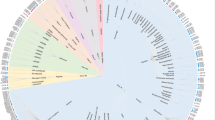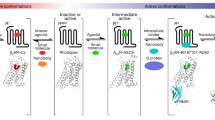Abstract
The G protein coupled receptors belong to the largest group of membrane proteins that regulates many essential physiological properties and represents an important class of drug targets. In this chapter, we show how the synergy between a laboratory experiment and computational modeling leads to structural delineation of the ligand binding pocket and how the knowledge of ligand–protein interactions is used for rational local and global drug design in which the structural knowledge of a particular receptor and its ligands is used for drug design of this particular GPCR and others.
Access this chapter
Tax calculation will be finalised at checkout
Purchases are for personal use only
Similar content being viewed by others
References
Tikhonova IG, Best RB, Engel S, Gershengorn MC, Hummer G, Costanzi S (2008) Atomistic insights into rhodopsin activation from a dynamic model. J Am Chem Soc 130(31):10141–10149
Kobilka BK, Deupi X (2007) Conformational complexity of G-protein-coupled receptors. Trends Pharmacol Sci 28(8):397–406
Johnston CA, Siderovski DP (2007) Receptor-mediated activation of heterotrimeric G-proteins: current structural insights. Mol Pharmacol 72(2):219–230
Thompson MD, Cole DE, Jose PA (2008) Pharmacogenomics of G protein-coupled receptor signaling: insights from health and disease. Methods Mol Biol 448:77–107
Palczewski K, Kumasaka T, Hori T et al (2000) Crystal structure of rhodopsin: A G protein-coupled receptor. Science 289(5480):739–745
Teller DC, Okada T, Behnke CA, Palczewski K, Stenkamp RE (2001) Advances in determination of a high-resolution three-dimensional structure of rhodopsin, a model of G-protein-coupled receptors (GPCRs). Biochemistry 40(26):7761–7772
Li J, Edwards PC, Burghammer M, Villa C, Schertler GF (2004) Structure of bovine rhodopsin in a trigonal crystal form. J Mol Biol 343(5):1409–1438
Okada T, Sugihara M, Bondar AN, Elstner M, Entel P, Buss V (2004) The retinal conformation and its environment in rhodopsin in light of a new 2.2 A crystal structure. J Mol Biol 342(2):571–583
Murakami M, Kouyama T (2008) Crystal structure of squid rhodopsin. Nature 453(7193):363–367
Park JH, Scheerer P, Hofmann KP, Choe HW, Ernst OP (2008) Crystal structure of the ligand-free G-protein-coupled receptor opsin. Nature 454(7201):183–187
Warne T, Serrano-Vega MJ, Baker JG et al (2008) Structure of a beta1-adrenergic G-protein-coupled receptor. Nature 454(7203):486–491
Rosenbaum DM, Cherezov V, Hanson MA et al (2007) GPCR engineering yields high-resolution structural insights into beta2-adrenergic receptor function. Science 318(5854):1266–1273
Cherezov V, Rosenbaum DM, Hanson MA et al (2007) High-resolution crystal structure of an engineered human beta2-adrenergic G protein-coupled receptor. Science 318(5854):1258–1265
Rasmussen SG, Choi HJ, Rosenbaum DM et al (2007) Crystal structure of the human beta2 adrenergic G-protein-coupled receptor. Nature 450(7168):383–387
Jaakola VP, Griffith MT, Hanson MA et al (2008) The 2.6 Angstrom crystal structure of a human A2A adenosine receptor bound to an antagonist. Science 322(5905):1211–1217
Evers A, Hessler G, Matter H, Klabunde T (2005) Virtual screening of biogenic amine-binding G-protein coupled receptors: comparative evaluation of protein- and ligand-based virtual screening protocols. J Med Chem 48(17):5448–5465
Tikhonova IG, Sum CS, Neumann S et al (2007) Bidirectional, iterative approach to the structural delineation of the functional “chemoprint” in GPR40 for agonist recognition. J Med Chem 50(13):2981–2989
Bissantz C, Bernard P, Hibert M, Rognan D (2003) Protein-based virtual screening of chemical databases. II. Are homology models of G-Protein coupled receptors suitable targets? Proteins 50(1):5–25
Archer-Lahlou E, Tikhonova I, Escrieut C et al (2005) Modeled structure of a G-protein-coupled receptor: the cholecystokinin-1 receptor. J Med Chem 48(1):180–191
Klabunde T, Hessler G (2002) Drug design strategies for targeting G-protein-coupled receptors. Chembiochem 3(10):928–944
Krystek SR Jr, Kimura SR, Tebben AJ (2006) Modeling and active site refinement for G protein-coupled receptors: application to the beta-2 adrenergic receptor. J Comput Aided Mol Des 20(7–8):463–470
Dufresne M, Seva C, Fourmy D (2006) Cholecystokinin and gastrin receptors. Physiol Rev 86(3):805–847
Archer E, Maigret B, Escrieut C, Pradayrol L, Fourmy D (2003) Rhodopsin crystal: new template yielding realistic models of G-protein-coupled receptors? Trends Pharmacol Sci 24(1):36–40
Poirot SS, Escrieut C, Dufresne M et al (1994) Photoaffinity labeling of rat pancreatic cholecystokinin type A receptor antagonist binding sites demonstrates the presence of a truncated cholecystokinin type A receptor. Mol Pharmacol 45(4):599–607
Kennedy K, Escrieut C, Dufresne M, Clerc P, Vaysse N, Fourmy D (1995) Identification of a region of the N-terminal of the human CCKA receptor essential for the high affinity interaction with agonist CCK. Biochem Biophys Res Commun 213(3):845–852
Kennedy K, Gigoux V, Escrieut C et al (1997) Identification of two amino acids of the human cholecystokinin-A receptor that interact with the N-terminal moiety of cholecystokinin. J Biol Chem 272(5):2920–2926
Henderson R, Baldwin JM, Ceska TA, Zemlin F, Beckmann E, Downing KH (1990) Model for the structure of bacteriorhodopsin based on high-resolution electron cryo-microscopy. J Mol Biol 213(4):899–929
Campagne F, Jestin R, Reversat JL, Bernassau JM, Maigret B (1999) Visualisation and integration of G protein-coupled receptor related information help the modelling: description and applications of the Viseur program. J Comput Aided Mol Des 13(6):625–643
Gigoux V, Maigret B, Escrieut C et al (1999) Arginine 197 of the cholecystokinin-A receptor binding site interacts with the sulfate of the peptide agonist cholecystokinin. Protein Sci 8(11):2347–2354
Gigoux V, Escrieut C, Silvente-Poirot S et al (1998) Met-195 of the cholecystokinin-A receptor interacts with the sulfated tyrosine of cholecystokinin and is crucial for receptor transition to high affinity state. J Biol Chem 273(23):14380–14386
Gigoux V, Escrieut C, Fehrentz JA et al (1999) Arginine 336 and asparagine 333 of the human cholecystokinin-A receptor binding site interact with the penultimate aspartic acid and the C-terminal amide of cholecystokinin. J Biol Chem 274(29):20457–20464
Giragossian C, Mierke DF (2001) Intermolecular interactions between cholecystokinin-8 and the third extracellular loop of the cholecystokinin A receptor. Biochemistry 40(13):3804–3809
Giragossian C, Sugg EE, Szewczyk JR, Mierke DF (2003) Intermolecular interactions between peptidic and nonpeptidic agonists and the third extracellular loop of the cholecystokinin 1 receptor. J Med Chem 46(16):3476–3482
Ji Z, Hadac EM, Henne RM, Patel SA, Lybrand TP, Miller LJ (1997) Direct identification of a distinct site of interaction between the carboxyl-terminal residue of cholecystokinin and the type A cholecystokinin receptor using photoaffinity labeling. J Biol Chem 272(39):24393–24401
Hadac EM, Pinon DI, Ji Z et al (1998) Direct identification of a second distinct site of contact between cholecystokinin and its receptor. J Biol Chem 273(21):12988–12993
Ding XQ, Pinon DI, Furse KE, Lybrand TP, Miller LJ (2002) Refinement of the conformation of a critical region of charge–charge interaction between cholecystokinin and its receptor. Mol Pharmacol 61(5):1041–1052
Galas MC, Lignon MF, Rodriguez M et al (1988) Structure–activity relationship studies on cholecystokinin: analogues with partial agonist activity. Am J Physiol 254(2 Pt 1):G176–G182
Archer-Lahlou E, Escrieut C, Clerc P et al (2005) Molecular mechanism underlying partial and full agonism mediated by the human cholecystokinin-1 receptor. J Biol Chem 280(11):10664–10674
Crocker E, Eilers M, Ahuja S et al (2006) Location of Trp265 in metarhodopsin II: implications for the activation mechanism of the visual receptor rhodopsin. J Mol Biol 357(1):163–172
Marco E, Foucaud M, Langer I, Escrieut C, Tikhonova IG, Fourmy D (2007) Mechanism of activation of a G protein-coupled receptor, the human cholecystokinin-2 receptor. J Biol Chem 282(39):28779–28790
Escrieut C, Gigoux V, Archer E et al (2002) The biologically crucial C terminus of cholecystokinin and the non-peptide agonist SR-146, 131 share a common binding site in the human CCK1 receptor. Evidence for a crucial role of Met-121 in the activation process. J Biol Chem 277(9):7546–7555
Martin-Martinez M, Marty A, Jourdan M et al (2005) Combination of molecular modeling, site-directed mutagenesis, and SAR studies to delineate the binding site of pyridopyrimidine antagonists on the human CCK1 receptor. J Med Chem 48(15):4842–4850
Silvente-Poirot S, Escrieut C, Gales C et al (1999) Evidence for a direct interaction between the penultimate aspartic acid of cholecystokinin and histidine 207, located in the second extracellular loop of the cholecystokinin B receptor. J Biol Chem 274(33):23191–23197
Gales C, Poirot M, Taillefer J et al (2003) Identification of tyrosine 189 and asparagine 358 of the cholecystokinin 2 receptor in direct interaction with the crucial C-terminal amide of cholecystokinin by molecular modeling, site-directed mutagenesis, and structure/affinity studies. Mol Pharmacol 63(5):973–982
Langer I, Tikhonova IG, Travers MA et al (2005) Evidence that interspecies polymorphism in the human and rat cholecystokinin receptor-2 affects structure of the binding site for the endogenous agonist cholecystokinin. J Biol Chem 280(23):22198–22204
Foucaud M, Tikhonova IG, Langer I et al (2006) Partial agonism, neutral antagonism, and inverse agonism at the human wild-type and constitutively active cholecystokinin-2 receptors. Mol Pharmacol 69(3):680–690
Rodriguez-Barrios F, Balzarini J, Gago F (2005) The molecular basis of resilience to the effect of the Lys103Asn mutation in non-nucleoside HIV-1 reverse transcriptase inhibitors studied by targeted molecular dynamics simulations. J Am Chem Soc 127(20):7570–7578
Foucaud M, Marco E, Escrieut C, Low C, Kalindjian B, Fourmy D (2008) Linking non-peptide ligand binding mode to activity at the human cholecystokinin-2 receptor. J Biol Chem 283(51):35860–35868
Chen JZ, Wang J, Xie XQ (2007) GPCR structure-based virtual screening approach for CB2 antagonist search. J Chem Inf Model 47(4):1626–1637
Bissantz C, Schalon C, Guba W, Stahl M (2005) Focused library design in GPCR projects on the example of 5-HT(2c) agonists: comparison of structure-based virtual screening with ligand-based search methods. Proteins 61(4):938–952
Vaidehi N, Schlyer S, Trabanino RJ et al (2006) Predictions of CCR1 chemokine receptor structure and BX 471 antagonist binding followed by experimental validation. J Biol Chem 281(37):27613–27620
Radestock S, Weil T, Renner S (2008) Homology model-based virtual screening for GPCR ligands using docking and target-biased scoring. J Chem Inf Model 48(5):1104–1117
de Graaf C, Rognan D (2008) Selective structure-based virtual screening for full and partial agonists of the beta2 adrenergic receptor. J Med Chem 51(16):4978–4985
Evers A, Klabunde T (2005) Structure-based drug discovery using GPCR homology modeling: successful virtual screening for antagonists of the alpha1A adrenergic receptor. J Med Chem 48(4):1088–1097
Cavasotto CN, Orry AJ, Murgolo NJ et al (2008) Discovery of novel chemotypes to a G-protein-coupled receptor through ligand-steered homology modeling and structure-based virtual screening. J Med Chem 51(3):581–588
Becker OM, Marantz Y, Shacham S et al (2004) G protein-coupled receptors: in silico drug discovery in 3D. Proc Natl Acad Sci U S A 101(31):11304–11309
Kellenberger E, Springael JY, Parmentier M, Hachet-Haas M, Galzi JL, Rognan D (2007) Identification of nonpeptide CCR5 receptor agonists by structure-based virtual screening. J Med Chem 50(6):1294–1303
Tikhonova IG, Sum CS, Neumann S et al (2008) Discovery of novel agonists and antagonists of the free fatty acid receptor 1 (FFAR1) using virtual screening. J Med Chem 51(3):625–633
Engel S, Skoumbourdis AP, Childress J et al (2008) A virtual screen for diverse ligands: discovery of selective G protein-coupled receptor antagonists. J Am Chem Soc 130(15):5115–5123
Kratochwil NA, Malherbe P, Lindemann L et al (2005) An automated system for the analysis of G protein-coupled receptor transmembrane binding pockets: alignment, receptor-based pharmacophores, and their application. J Chem Inf Model 45(5):1324–1336
Rognan D (2007) Chemogenomic approaches to rational drug design. Br J Pharmacol 152(1):38–52
Klabunde T (2007) Chemogenomic approaches to drug discovery: similar receptors bind similar ligands. Br J Pharmacol 152(1):5–7
Martin RE, Green LG, Guba W, Kratochwil N, Christ A (2007) Discovery of the first nonpeptidic, small-molecule, highly selective somatostatin receptor subtype 5 antagonists: a chemogenomics approach. J Med Chem 50(25):6291–6294
Bock JR, Gough DA (2005) Virtual screen for ligands of orphan G protein-coupled receptors. J Chem Inf Model 45(5):1402–1414
Author information
Authors and Affiliations
Corresponding author
Editor information
Editors and Affiliations
Rights and permissions
Copyright information
© 2010 Springer Science+Business Media, LLC
About this protocol
Cite this protocol
Tikhonova, I.G., Fourmy, D. (2010). The Family of G Protein-Coupled Receptors: An Example of Membrane Proteins. In: Lacapère, JJ. (eds) Membrane Protein Structure Determination. Methods in Molecular Biology, vol 654. Humana Press, Totowa, NJ. https://doi.org/10.1007/978-1-60761-762-4_23
Download citation
DOI: https://doi.org/10.1007/978-1-60761-762-4_23
Published:
Publisher Name: Humana Press, Totowa, NJ
Print ISBN: 978-1-60761-761-7
Online ISBN: 978-1-60761-762-4
eBook Packages: Springer Protocols




